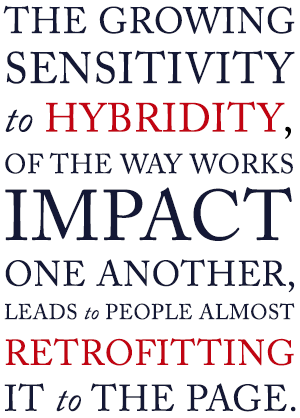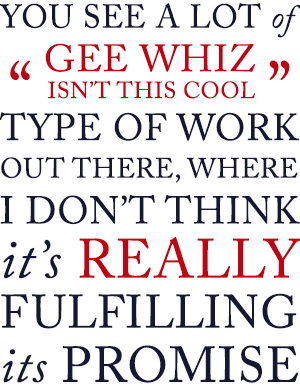On Hybridity

In late October of this year, Bellingham Review Hybrid Editor, Megan Spiegel, sat down with Susanne Paola Antonetta, Editor-in-Chief, to talk about hybridity, the role of the rise of digital publishing, and the Review’s new Hybrid Forms section.
Antonetta’s essay, Riddling the Sphinx: An Introduction to Hybridity, can be found in Family Resemblance: An Anthology and Exploration of 8 Hybrid Literary Genres, which was released by Rose Metal Press in November.
Megan Spiegel: How would you define hybridity?
Susanne Paola Antonetta: Well, I think that it is when there is more than one meaning-making mode, in which each one in some sense exerts a force and changes the other. And “meaning-making mode” is amorphous, in that it covers language, genre, art and anything visual—so I think it’s a useful term. I think the important thing is that there has to be that sense of change, that each container gets morphed in some way or pulled at by the other.
 The example I always give is if you’re reading a biography, and it’s kind of an old-fashioned one—you’ll read a biography of maybe Ronald Reagan, and you’ll hear about how he met with this world leader, and in the book you will see some photos of that world leader. And in that case the photography does nothing. It’s a little eye-candy, a little proof maybe it happened, but it doesn’t change the story or the meaning or anything like that.
The example I always give is if you’re reading a biography, and it’s kind of an old-fashioned one—you’ll read a biography of maybe Ronald Reagan, and you’ll hear about how he met with this world leader, and in the book you will see some photos of that world leader. And in that case the photography does nothing. It’s a little eye-candy, a little proof maybe it happened, but it doesn’t change the story or the meaning or anything like that.
I think to be a hybrid, for photography to be present it has to somehow change the words.
MS: That makes sense. So it seems like the idea of hybrid forms has been gaining a lot of momentum and currency recently, with more journals opening up specific hybrid submissions categories, and small presses like Rose Metal publishing hybrid or cross-genre work. When did you start seeing this sort of movement in contemporary writing, and what has that looked like from your perspective?
SPA: Well I think that we have two things. There’s the rise of digital publishing in which hybridity is almost in some senses a thrown-off side effect, one that over time we’ve all become sensitized to. You take a journal like Brevity, where they put in some artwork with each piece, but there are times when the artwork is interacting with the piece in really interesting ways. Sometimes it even seems to contradict or offer an alternative narrative. And of course we have link-node organization where you get to a word and that can send you to another word and you can choose not to go.
So I think a kind of hybridity is built into that, and it’s made us sensitive to it. The growing sensitivity to hybridity, of the way works impact one another, leads to people almost retrofitting it to the page. It’s really interesting when this artwork is there and it’s doing something that almost challenges what the words are; it’s changing the words, it’s creating this question about reliability, this slippage with the language. So maybe I can bring that back and do it in the book. You can actually see the digital curiosities start showing up on the page. And you see things like Anne Carson’s Nox where it’s a book, but when it unfolds, there’s Latin words…
 MS: Stuff goes across multiple pages—
MS: Stuff goes across multiple pages—
SPA: Yeah, stuff breaks the page. So I don’t think that it’s that new. I think digital publishing, with all the things that come with that, has pushed it a bit and has sensitized us, and as we’ve become sensitized we’ve become— kind of delighted! It really is cool, when you organize something and it’s doing more than just one component, whether that component is a poem, or a short essay, or whatever. Hybridity has always been around. We’ve just become better at talking about it, at being aware of it.
MS: So what kinds of hybrids have you worked with in your own writing, and what led you to experimentation in that direction, if you have done that? It seems like you have.
Oh, certainly. I’m really interested in how the language and imagery of science comes up against the lyric voice. I would say that’s where my interest has always been sited. In my first book of nonfiction, Body Toxic, I didn’t have the budget to include much that was visual, but I included this wonderful image of a nauseated human face that they were using at the Yucca Mountain waste repository. They realized when they created a nuclear waste repository, that by the time it was no longer dangerous there would no longer be a language on the planet that anyone knew. It’s an amazing thought, not in a good way. So they tried to create this kind of stone stele that shows a nauseated human—he’s hairless; it looks like he has radiation poisoning—hoping that people speaking whatever they speak then will recognize it. And that kind of became a little emblem in that book. And I used language straight from the EPA. I used a lot of documentation there, for a sort of mixing of that dry, clinical language with the effects of the pollutants they were describing. So that’s been my interest. I’ve not used too much in the way of photography in my own work, but I do love that.
 MS: When do you think hybrids work most effectively or most powerfully?
MS: When do you think hybrids work most effectively or most powerfully?
I’d have to say again, I feel they’re most powerful when there’s a very strong cross-current between the two genres or modes that you’re using. I think in Judith Kitchen’s Half in Shade, the photography and the words work in such a fascinating dynamic with one another, in that she’s creating a lot of interpretive acts, but sometimes the photographs almost don’t seem to contain the interpretive acts. You experience this kind of slippage that shows you where the author’s hand is in the work. I think that’s super important.
In regards to this phase now where we’ve acknowledged hybridity, we’ve defined it, we’re talking about it, you see a lot of “gee whiz isn’t this cool” type of work out there, where I don’t think it’s really fulfilling its promise.
MS: Right. So, what kinds of works are you excited to maybe see in the Bellingham Review, either in the digital version or the print version?
I know this is a silly answer, but I have to say whatever is really good and challenging, and whatever I haven’t seen before. That’s what I’m most excited about. I want somebody to just surprise me, completely. You know, there’s a wonderful hypertext piece, but it’s very simple, called “Fitting the Pattern, Or Being the Dressmaker’s Daughter,” [by Christine Wilks] I think I might have shown it to you, where you sew a dress. This woman was the daughter of a dressmaker, and in sewing the dress you reveal her memoir. And it’s just so smart and so performative. Things like that make me excited.
MEGAN SPIEGEL is an MFA candidate in Creative Writing at Western Washington University, and serves as a hybrid genre editor for Bellingham Review. Recent work has appeared or is forthcoming in Fugue and Sweet.